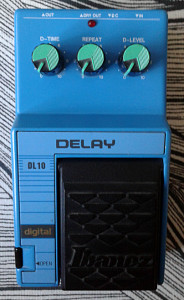What is it?
Ibanez DL10 Digital Delay from Power series. Made in japan between 1986-1989.
The Ibanez delays are usually highly praised and for a reason. Solid construction and nice design. When i think of it, many other types have design flaws. This of course isn’t limited to just Ibanez. Still. usable delays are more common than, for example, usable distortions. The design here seems to be pretty much the same as found on DL5, or, we could once again argue that DL5 is just a remake of this unit. Opening the standard 10-serie box shows a couple of components mounted on the solder side of the board. This always makes me a little suspicious. This time, i think the components are there by the manufacturing process. I reached this conclusion by having obtained a second DL10 in defunct state. Or it would be highly unlikely that two separate units (one bought from canada and the other from a local guitarist) have the exactly same mod performed on them.
Hand drawn acid trip traces always make me smile. This time there’s another vow-factor due to crowded digital board and the hand drawn traces. Heart of the delay circuitry is Mitsubishi M50195P, which is one of the standard echo family chips Ibanez has used on most of their delay circuits. Including Master series Flanger and a lot of others.
Good delay pedal needs to be simple to use and still offer more controls than just one tone. The Power series delays are all pretty good items. This one is more of a simple standard, while the others offer more and more special features. Let’s face it. Maxon designers have had their spoons flying pretty high in the 80’s. After all, there are seven different delay designs in a series which was manufactured from 1986 to 1989.
How does it sound?
Like a very nice delay with reasonably good control range. This stretches from tight slap back to neverending feedback with nice long delay time. This unit is common and lots of people are still using it for a good reason. Usable. Not much more to add.




Not sure if you can help me but I have picked up a used DL10 and it seems to have a broken resistor(that jumps one leg of T43 to C45)
If you could shoot me the value if not still a great site here!
Thanks,
Dave
I was planning to answer you.. But i was a way when i got the message and then simply forgot. I’ll check it soon(ish)..
+m
Oddly enough I just picked up two Yamaha PH-100 Phase Shifters (MIJ). One has a MODE not working the other is fine. The latter has exactly the same modifications as shown above on your Ibanez pedal (and works fine). I recalled reading this post, so checked back. Appears to be some extra grounding to the outer casing/screw sockets from the PCB and a small piece of wire bridging over the power supply input. Very odd!
I’m beginning to think a new regulation may have come into force at that particular time in Japan requiring the alteration.
Hi!
I just got a DL10 in nearly mint condition with a very odd issue: The dry signal is fine, but there is no delay signal at all (output quiet when I put a plug in the dry output). I have already fixed a cold/broken solder joint on the DC socket but I’m out of ideas. Do you have an idea what to look for?
Thanks
My first suggestion would be to take an audio probe and find where the signal dies. Something like this: https://www.diystompboxes.com/pedals/debug.html
Next, i’d use a DMM to determine if 4558s get the right voltages. Then i’d check the regulator and the voltages on the digital part to see if there’s something wrong with those.
AFAIK there’s no schem around, so it’ll take a bit of effort.
Usually some part of the effect circuit doesn’t get power while the bypass side works fine. Could be a broken joint or a dead cap. Those are way more common issues than a dead semiconductor.
Good luck. I hope you find the issue.
+m